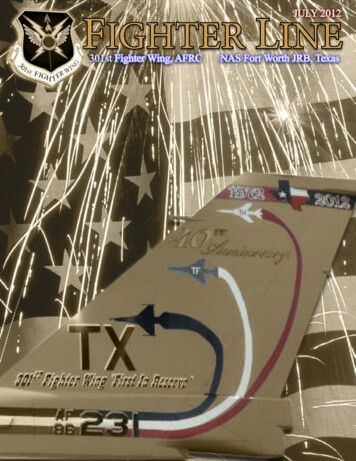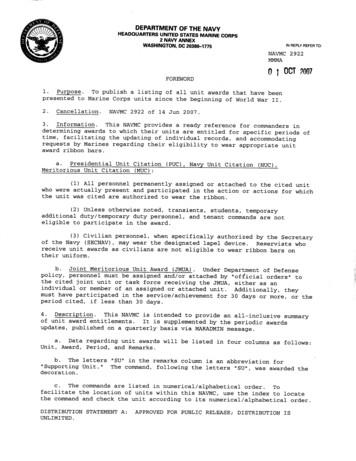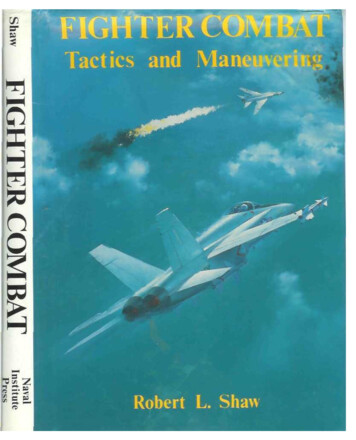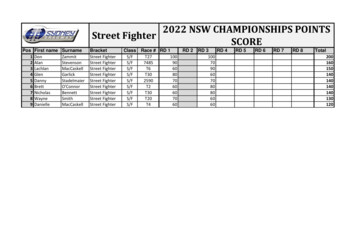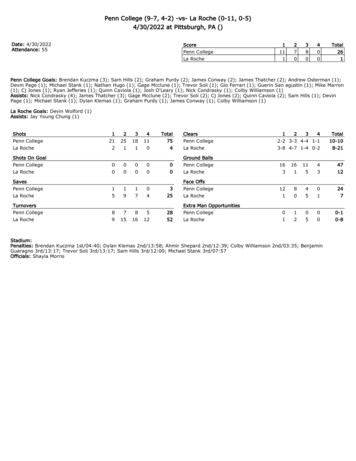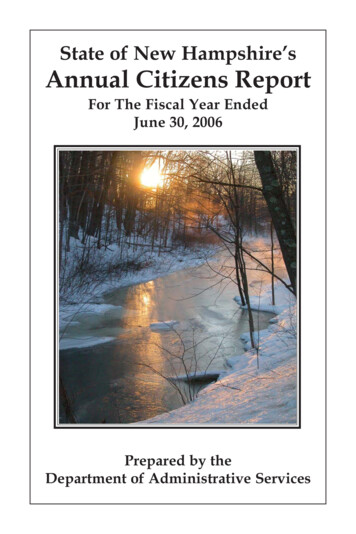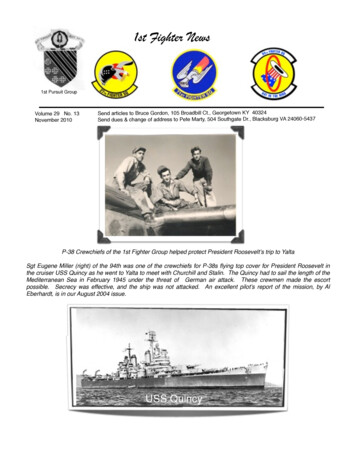
Transcription
!1st Fighter News1st Pursuit GroupVolume 29 No. 13!November 2010! !Send articles to Bruce Gordon, 105 Broadbill Ct., Georgetown KY 40324!Send dues & change of address to Pete Marty, 504 Southgate Dr., Blacksburg VA 24060-5437P-38 Crewchiefs of the 1st Fighter Group helped protect President Rooseveltʼs trip to YaltaSgt Eugene Miller (right) of the 94th was one of the crewchiefs for P-38s flying top cover for President Roosevelt inthe cruiser USS Quincy as he went to Yalta to meet with Churchill and Stalin. The Quincy had to sail the length of theMediterranean Sea in February 1945 under the threat of German air attack. These crewmen made the escortpossible. Secrecy was effective, and the ship was not attacked. An excellent pilotʼs report of the mission, by AlEberhardt, is in our August 2004 issue.USS Quincy
November 2010!Page !President:271st WW II DiaryJim “Raquet” Hardenbrook9 Canal Drive Podquoson, VA 23662757-850-5581 ejhbrook@aol.comPresident Emeritus:Bill “Frito” Lay6305 Compass Court, Suffolk, VA 23435757-484-1690 laytw@aol.comVice President:Bob Correia3 Midway Drive, Warwick, RI 02886-8114401-737-3268 robtcorr@verizon.netSecretary/Treasurer:Pete “Pistola” Marty504 Southgate Dr., Blacksburg, VA 24060-5437757-850-5581 1stFighter@Comcast.net1st Fighter Website: http://www.1stFighter.comWebmaster: Steve “Buick” Oldssteve.olds@stratworx.comAs everyone is aware, the Association, thru MacMacAllister, presented the 1st Fighter Wing withthe original copy of the 71st WWII diary. Thenote below from the Wing Historian providessome detail on how the diary is being preservedand shown for all to view in the foyer of the WingH Q b u i l d i n g . A d d i t i o n a l l y, t o e n h a n c epreservation the plan is to have a more recentcopy available for folks to review the diary without disturbing the original. Hopefully the USAFwill pick up the reproduction tab.The Historian would like to display the diary withpatches from the other 2 squadrons. Althoughhe does not state I am almost sure he would likepatches dating back to as early as possible andup to present day. If possible please query yourfolks to see what we have available for displayalong with the diary and 71st patches.Squadron Officers:27th! Pres: Roy E. “Bubba” Parker 817-473-0610The Historian, Brian Laslie, says:!!!!!The Air Force Historical research Agency has ahigh speed scanner that I might be able to makeuse of the next time I am down there this fall. Asfar the original goes I have put it on display in thelobby of the 1 Fighter wing as part of my updateto our historical collections. It is under glass andlocked, however from time to time I will turn thepages and go different entries. I have it settingnext to both a 1 Fighter Group emblem from theera as well as an original 71st patch. More tofollow as I make the 1 FW archives worthy of itsrich history and heritage.parkere1@yahoo.comSec/Tres: Bob Correia 401-737-3268robtcorr@verizon.net71st! Pres: Jon “Goldy” Goldenbaum!!!PO Box 190 Warner Springs, CA 92086Cell: 951-203-0190 Work: 1-800-362-3490jon@conaircraft.com94th! Pres: James C. “Jumbo” Wray 850-625-7235!Jumbo@knology.net!VP: Ragin Hause “Rags” 706-265-8393!!Rhause01@windstream.netSec/Treas: Bruce Gordon 502-370-5240Editor:!Bruce Gordon brugor@mac.com!105 Broadbill Ct. Georgetown KY 40324I'll tell you what I'd like to archived here in the HQare patches from the 27 and 94 as well. If youhave any contacts or know of anyone willing todonate items please let me know.-BrianIn MemoriamFrancis Fiedler!Marvin Green!Irv Styer!71st71st27thBrian D. Laslie1st Fighter Wing Historian
November 2010!Page !3Note from the SecretaryAs of this publication there are 348 active members of the Association of which 54 are Life Members. Lookfor a mailing in January for the annual membership drive.PeteRACQUET’S REMARKSTHE DEED IS DONE!! At 0971[1011 EST] on 30 Sept 2010the last nail was put in the 71stFS coffin, at least for a littlewhile. At that time, in the 71sthangar, L/C Joel “Knuckle Cook,shown on the right, furled theSquadron flag for the last time andpresented it to Col Richard “Chase”Boutwell, 1st FW Operations GroupCommander It is the end of anActive-duty era for this landmark Squadron but the traditions and heritage will liveon in our Association to be remembered and practiced for years to come.
November 2010!Page !4To that end we have madearrangements with L/C Cook, former71st/CC, to collect up all theremaining Squadron memorabiliaand have that for sale during thenext reunion. Additionally, aninterim display of 71st memorabiliato include the original WWII Diarythat Mac McAllister presented toCol. Molloy, 1st FW/CC, and anoriginal 71st WWII patch are now ondisplay in the foyer of the 1st FWHeadquarter’s Building.Your Association is working with thenew 1st FW historian, Brian Laslie,shown with Racquet, to display as much of our memorabilia as can be practicallydisplayed in the limited space available.Our latest addition, by way of Randy “Mopar” Dodge is a virgin 27th patch that Randy hasbeen holding on to from his active duty days. This patch is our next addition.We are working with the Historian, 27th Squadron/CC and the Wing to receive an ACCwaiver to place a Maloney’s Pony logo on a Raptor. Things were moving slowly while the27th was TDY but I expect the pace topick up in the weeks ahead andhopefully we will receive approval tomove forward. We will get the word outwhen we know something.Lastly, your Board, in coordination withJon Goldenbaum, have been working tocoordinate our next Reunion and I ampleased to announce that we havesettled on a location, the Riverside, CAarea, dates 14-17 September, 2011 andwe are in the final discussion withpotential hotels to achieve the bestcombination of rates and facilities. Somark you calendars for another greatReunion in a historically significant location from the 1st Fighter Wing and 1st FighterAssociation’s past.Check 6Racquet
November 2010!Page !5A DEAD WEEDThe Word from BubbaEditorʼs Note: Among the photos from the 71st deactivation were photos of a bottle ofJeremiah Weed. I looked it up on Wikipedia and saw this:Jeremiah Weed is a bourbon liqueur manufactured in Connecticut and sold in limited quantities inthe United States, mostly at and around Air Force installations. Its alcohol content by volume is50% (100 proof). Jeremiah Weed is a product of Diageo.Jeremiah Weed has earned notoriety and has become a favorite drink of the American fighterpilot, especially in the United States Air Force. It is so popular among this demographic that it hasgained a cult following. Jeremiah Weed is a very significant element of American fighter pilotculture; how it came to be the drink of the fighter pilot is a matter of legend.[1]The fighter pilot band Dos Gringos wrote a song titled "Jeremiah Weed" for their album Live at theSand Trap about this notorious pilot's beverage. Gary Jules also produced a song titled "JeremiahWeed" in 1998. Ohio troubadour Eric Nassau has also recorded an ode to Jeremiah Weed"Jeremiah Weed" for his 2009 record What's Left of Empty Space.I asked Bubba what was important about the bottle - and got this reply:
November 2010!Page !6Here is the true story behind Jeremiah Weed. Jumbo, Goldy, and others can attest to it'sauthenticity. Nort Nelson and Joe Bob Phillips are modern day legends (and still goingstrong, I might add). I spent two years in Saudi with Nort from 2001-2002 and he hasn'tchanged. Also spent time with Joe Bob at Fort Worth when he was in BD at LockheedMartin.To this day, every fighter squadron bar keeps a bottle of weed on the bar.Normallycovered in tape. If you pick it up, you have to pour a shot. If it's the last shot, you owe thebar another bottle.'The True Story of Jeremiah Weed'From 'Sierra Hotel - Flying Air Force Fighters in the Decade After Vietnam ', byColonel Clarence Richard "Dick" Anderegg, USAF, (Retired)Every USAF fighter squadron has a lounge where the pilots sometimes gather for acold beer after the flying day is over. Every refrigerator in each of those loungescontains a chilled bottle of a 100-proof product called Jeremiah Weed. For specialoccasions, and sometimes for no reason at all, someone will bring out the Weed, fill ashot glass for each person present, and propose a toast. At the conclusion of thetoast, all down their Weed in a single gulp. It is not tasty. To many it seems likedrinking kerosene, and it leaves a very strong aftertaste. Be that as it may, fewrefuse because the downing of a Weed is a ritual deeply imbedded in the fighter pilotculture. That ritual started long before today’s squadron commanders were even incollege, and stories abound as to how the custom started. A famous newsman oncesaid, “When there is disagreement between the legend and the truth, always print thelegend.” Since I disagree, here is the true story of Jeremiah Weed, and I know it’strue because I was part of it.On December 1, 1978, I was flying as an instructor in the back seat of a F–4E, tailnumber 649, on a BFM hop out of the 414th FWSq at Nellis Air Force Base, Nevada.The student in my front seat, Maj. Nort Nelson, was a highly experienced F–4 pilotwith hundreds of combat hours. Leading the flight was Capt. Joe Bob Phillips, whohad in his back seat Capt. Larry Ernst, an instructor who was just along for the ride.The mission called for Joe Bob to attack Nort in a scripted scenario that gave Nort theopportunity to use his best defensive BFM to defeat Joe Bob’s attacks. The missiondid not last long. On the first engagement, Nort managed to put the airplane into aposition from which I judged that recovery was impossible (The details are foranother story, which I will tell in a future book). I ejected both of us from the jet.Neither of us was injured, and within an hour we were picked up by a helicopter thatreturned us to Nellis. It probably goes without saying that Nort and I had differentviews: he thought he could miss the ground; I did not. It was too close to bet my life
November 2010!Page !7on. The accident investigators agreed with me. They determined that ejection was theonly possibility for survival. Further, they believed that if I had delayed more than asecond, one or both of us would have died in the desert seventy miles north of LasVegas.A year later, both Joe Bob and Nort were members of the F–16 MultinationalOperational Test and Evaluation squadron at Hill Air Force Base, Utah. On the firstanniversary of the accident, they were flying to Nellis to participate in Red Flag. Asthey passed over the crash site, which Joe Bob easily found since he had circled ourdowned position many times, they sketched some brief road maps on cards in theircockpits and decided to return to the site by car.The next day, a Friday, they drove out of Las Vegas with a friend, Pete Mock,intending to find the site and camp out in the crater that the crashing airplane hadgouged in the high desert. However, it was dark by the time they got to the dirt roadthey thought would lead them to the site. After a couple of aborted attempts to driveup dirt roads to nowhere, they decided to go back to a roadside café they had passedto ask directions.They entered the Paranaghat Bar and found no customers, only a bearded bartenderwho looked a lot like Grizzly Adams. When they told the bartender what they were upto, he was delighted to tell them he had seen the fire from the crashing airplane theday of the accident. Further, he was very pleased that he had three real fighter pilotsin his bar. He had heard that fighter pilots knew many bar games (true), and hewanted to play games for drinks. When they balked at the idea, he persisted, andafter much cajoling asked them if they knew the game “horses.” They shook theirheads no (not true). Over the next several minutes, the bartender “taught” themhorses, finally saying that whoever lost had to buy a round of drinks. After threegames of horses, the bartender had bought all three rounds. And after three roundsthe pilots were a little less stressed to get to the crash site.Joe Bob asked the bartender if he knew how to do afterburners. No, the bartendersaid, he had never heard of that game. So, Joe Bob explained to him how a shot ofbrandy in a shot glass is ignited so that the alcohol on top burns, and then thedrinker throws down the flaming shot. If done correctly, all the brandy is emptiedfrom the shot glass, so that when the drinker puts the glass down, a small, blueflame still burns in the bottom. The bartender was eager to play but said he had nobrandy. Nort suggested that any high-proof booze might work, and the bartenderfumbled around under the bar for a moment. He straightened up and plopped a tall,brown bottle with a brown and green label on the bar, and said, “I’ve got this herestuff—it’s 100 proof.” The brand name on the green label proclaimed that it wasJeremiah Weed. The three fighter pilots filled their shot glasses and demonstrated, allthree glasses returning to the bar empty except for a small blue flame flickering atthe bottom.
November 2010!Page !8The bartender immediately poured one for himself and lit the top. Now, these wereno ordinary twentieth-century shot glasses. Joe Bob thought they might be from the1800s because the glass was very thick, and the bottom was probably an inchof heavy glass. When the bartender picked his up, he held it by the bottomwhile he licked and smoothed the mustache of his thick beard out of the line offire. He took several moments on his grooming, not realizing that as he heldthe thick glass at the bottom, the top near the fire was heating quickly. By thetime he tilted his head back and put the glass to his lips .well, Joe Bob saysyou could probably hear the s-s-s-s-sizzle of the hot glass barbecuing thebartender’s lips halfway to Las Vegas. Then the bartender made his secondmistake and flinched. The flaming Weed went all over his beard, and by thetime Joe Bob, Nort, and Pete could beat out the flames, the bar was filled withthe smell of cooked lips and singed hair.As soon as things calmed down a bit, the trio, feeling badly that they had notpaid for a drink all night and greatly embarrassed that they had nearlyimmolated their new friend, bought another bottle of Weed from him and leftagain for the crash site, this time guided by one of the bartender’s friends whohad entered the bar just in time to witness and smell the blistering. The friendshowed them the correct dirt road, and the trio found the crash crater, wherethey spent the rest of the night camped out and drinking the entire bottle ofWeed.The next morning they dragged themselvesout of the crater, gathered a few souvenirsfrom the parts still lying around, and headedstraight for the Nellis Air Force Base Officers’Club. There they found the manager, showedher the empty bottle, and strongly suggestedshe add it to the bar stock. She did. Soon, theNellis fighter pilots were downing shots ofWeed (nonflaming) for no good reason exceptit was different, and it was a good excuse totoast “fallen comrades.” As Red Flags camethrough the Nellis club, they saw the weaponsschool guys doing it, so they did it, too.And that is the true story of how JeremiahWeed started. I have a bottle in my freezer.
November 2010!Page !9Editor’s Note: During the 1950’s the 1st Fighters flew the F-94 Starfighter, our first all weather jetinterceptor. It was based on the T-33 trainer with a more powerful engine and an afterburner. It sawaction as a night interceptor in the Korean War. Originally equipped with four .50 caliber guns in thenose, it was modified with 2.75” unguided rockets. The aircraft radar brought the fighter to a firingpoint where all the rockets were fired at once in a shotgun pattern, as any one hit could bring down abomber. The version here, the F-94C, carried24 rockets in the nose and another 24 in podsunder the wings. The nose rockets created somuch smoke that they blinded the crew andcould cause the engine to flame out. The F-94was replaced by the F-86D with a rocket podunder the nose, and then by the F-102 whichhad our first guided missiles but still had 24rockets inside the missile bay doors. The 1stFighters flew all these airplanes.The 1st Fighters have very few stories fromthat period, so this story by Dan Riley and hisphotos are presented for your enjoyment. Subject: Big MistakeTo: Roy ParkerDate: Thursday, October 7, 2010, 3:31 PM"Bubba", you certainly have a way with thevernacular! Although you didn't ask a directquestion about the Moody AFB caper, youhinted at it. Big mistake, that was incentiveenough for me!My passion for telling stories hit a peak in1997, when I was the coordinator for our firstever Class 54Q Pilot Training reunion. One dayI found a big note on the door of our hospitalityroom which said, "Don't ask Riley anyquestions, we're only going to be here threedays!" One may have taken offense to that butI didn't.I took it as a compliment, and beganrecording all my military stories. I quit at 18chapters, and have since condensed them. Allthis was self serving, lest I got too old toremember, and some day it may give those achance who missed the stories, by leaving theroom. My four children were instrumental ingetting me started. I digressed.the Moody caper:During the Spring of 1955, the entire 27th Squadron went to Moody for rocket training on the Gulfwater range. Guts, feathers, and all. Enlisted, officers, and as I said.24 F-94Cs, a T-Bird and a
November 2010!Page !10B-25. I think we were due to stay there 30 days. Burlington VT picked up our alert for us. Wewere housed in old WW2 barracks converted to rooms. After about a week, the new wore offand the adventures began. It was about 1 AM when I awoke to a loud rumbling sound comingfrom the hallway. It was a long hallway, the original old wooden floor, running the entire lengthof the building. The rumbling always ended with a much louder "crash".Pete Gauchus was an RO, and a young athletic type. We were all young, and I was a newbrown bar. When I opened my door, I saw a drunk Pete at one end of the hall rolling his shotput, bowling ball fashion, at a Sunroc water cooler at the other end of the hall. The shot-putmust have been doing about 40 when it passed me. He succeeded, hitting the cooler andconverting it to scrap metal. The water line broke and looked like Old Faithful.Col Davenport was the Base Commander and he blew his top. Who could blame him.Incidentally, he had his own personal F-94C parked in front of Base Ops. It glistened like it waschrome! Everything finally died down and was getting back to normal when it happened.I was awakened again, this time by my RO, John Staples. He was yelling, "Get up, get up, andstart packing!" Half asleep I asked, "Where are we going?" He replied "Back to Griffiss!" "Who'sgoing!" I asked. The next words were the shocker."The whole GD squadron. We've beenkicked off Moody."It seems a few hours earlier things got out of hand at the Moody Club, some 27th jocksapparently got mad, and started throwing everything they could get their hands on into theswimming pool. I didn't witness this but I was told it was pretty bad. A few hours later I was backin my room at Griffiss. But the crisis wasn't over. Later that night my Flt Cmdr, Capt Les Hauer,called and told me to flight plan for two F-94s to return to Moody early the next morning. He toldme when the enlisted people pulled out, they stole an enormous amount of Moody's GIblankets. Moody was holding our supply officer hostage. The blankets would be strapped intothe rear seats of the two aircraft. I was ready at Base Ops the next morning when Hauer walkedin and said they got all the blankets into one aircraft, but since I was already there, I may aswell go also. I called the BOQ and asked my RO if he wanted to go."Naw, I'm going back tobed." So I went with an empty back seat.Not much fuel on board an F-94 and it was two hops each way. Can you imagine somethinglike this happening today? Airplanes were cheap, flying hours were cheap, and no one reallycared about sortie utilization. I often wondered about the cost of those blankets vs the sorties toreturn them. Looking back, I know I was in at the right time!Now you know why. "Don't ask Riley any questions!"
November 2010!Page !111stFighter.com Website UpdateSeveral years ago the 1st Fighter Association made a commitment to build a new generationwebsite that would meet seven criteria.1. Memorialize the 1st Fighter Wing historical documents, photos, videos and stories that hadbeen part of the association website to date;2. Create a "members only" side of the website for dues paying members to access informationthat was not appropriate for the public (like Bubba doing shots of weed);3. Empower each member of the association to upload content from theirpersonal archives in the same categories as the historical information;4. Use a social network strategy to encourage existing members to reach out to former & active1st Fighters and encourage them to join the website and the association;5. Engage internal dialogue systems so members could connect, chat and develop a robust'virtual' camaraderie that would lead to growing membership;6. Manage a real time calendar system to ensure members could access all 1st Fighter relatedactivities, including active duty updates;7. Use technology to effectively inform, promote and facilitate reunion planning and execution.To accomplish these objectives, I worked with the executive team and many of the association'sfounding members to define specifications for the website, go/no-go items and a timeline. Mytechnical team identified what we believed to be the best programming solution to deliver what theassociation needed now. The site was also designed for future organizational growth withouthaving to rebuild a website every few years.At the Langley Reunion in 2009, we introduced the new platform and began to ramp up the userparticipation. During the first few months of operation many of our members used the site andattempted to load content and use some of the administrative features. Some of the site workedwell, but other parts were more challenging. As we continued to refine the site, we fixed bugs, andadded new features. For example, we added a simple landing page where new visitors couldidentify themselves as a member or guest and thus move to the appropriate part of the website.Designing websites is one thing, using them is another and maintaining them is yet another. Tomake sure the site could be easily maintained, earlier this year I positioned 1stFighter.com on USBased servers with a well established company in Lynchburg, Virginia with whom my companyhas done business for over 5 years. Several months ago, I was notified by the hosting companythat our website had to be taken offline because a hacker had violated our site and it was beingused to send out millions of virus emails.My team and the hosting company went to work immediately to identify the source of the intrusionand after what seemed like an eternity, we discovered there was a vulnerability in the open sourcecode upon which the member area of the website was built. Over the ensuing weeks, we had tofind all the viruses that had planted themselves in our site, remove them, plug the holes andprepare the site for re-launch. As of this writing, the website is online and we expect to have all theprogramming complete by the end of October.
November 2010!Page !12Lessons LearnedIn this day and age, websites are absolutely critical to organizational communication. I happilyvolunteered for the role as the next Association webmaster because I wanted to contribute to anorganization that means so much to me. I did my best to coordinate the project and produce aproduct that was in line with the associations budget and would meet the expanding list ofrequirements.However, as technical challenges came up, my role as the association's webmaster competedwith my full time business. I needed to be much more attentive than I was and the associationsuffered because of it. The association needs a dedicated, US based technical team available torespond web needs asap as opposed to an 'additional duty' webmaster.Action Steps1. The 1st Fighter Association now has a direct contract with the US Based company for hosting,technical programming support.2. The 1st Fighter Association 'webmaster' will serve more as a liaison to ensure specificationsfrom the executive team are communicated and carried out by the technical company.3. I'll buy the first round at the 2011 Reunion.Onward,BuickEditorʼs Note: A few additional questions further defined that:1) The large quantity of invaluable information on our previous website has not been lost.2) Online means the website is accessible through the internet as opposed to when it wassuspended offline while the virus was active.3) The way we designed the site means that members cannot upload anything that is seen by thepublic unless the executive team approves it and we publish it on the home page. With regard tomember content, we've not set any guidelines for content but we probably should. That's up to theboard to set general guideline.The main difference between now and the end of the month (or as soon as we are notified byprogrammers) is there is vulnerability FROM hackers to our site which in the worst case scenariocould take it offline until the holes are secured. Because the programmers were able to removethe viruses, they have been able to leave the site online and accessible. By 1 November,members can start uploading pix, video and documents again.---------------------------------The help of volunteers, such as Buick, is essential to the survival of the Association. Sometimesthings go wrong, but we still owe them our support and thanks for doing their best. Buickdeserves a toast at our next Reunion! --- Bruce
November 2010!Page !13Letters to the EditorThis Newsletter is open to deeper thoughts by our membership about air power and the future ofaviation. Keep politics out of it, but strategies and military budgets are fair game. To start it off,“Bubba” Parker, President of the 27th Fighter Squadron, sent this analysis:Bruce,Just a thought. I often speak to groups about the evolution of airpower from the great thinkerssuch as Douhet and Mitchell, the results of the strategic bombing survey, the horrible losses inWW-II, etc. What I focus on is the promise of Air Power - ability to strike directly at the will andcapability of a nation state to wage war without the horrible loss of life and treasury that groundwarfare entails.I would suggest to you that the promise of airpower has only started to be delivered. Gulf War Iwas the roll out of a new Air Force that people like Dixon, Creech, and Russ envisioned. What arethe capabilities I'm refering to? I would suggest the following:1. Precision guided munitions. When you look at the probability of kill of a target with a givenweapons system, it is fairly easy math to figure out how many sorties you need to achieve a givenPk of kills. As an example, in WW-II to guarantee destruction of a 50,000 square foot war houserequired 75 sorties to achieve a 95% probability of destruction. In Korea, there were someimprovements and the same target now took 50 sorties to achieve the same Pk. In Vietnam, therewere also some improvements - the same target now took 25 sorties to guarantee destruction. Ofcourse, each of these were exposed to horrible attrition, lose of aircraft, and lives. I would suggestin Gulf War I, we could launch a single F-117 and have the same probability of kill with a singleaircraft - and we got the aircraft back! (by the way, the figures are notional that I use above, butyou get the idea. I have actual numbers).2. Low Observable technology - Enables us to go into very heavily defended areas with minimumchance of detection as well as loss of the asset. Also minimizes/eliminates the need for ECM, etc.and all the assets required for that mission.3. Technologies that turn the night into day. We can now wage aerial warfare 24/7 with the sameeffectiveness. No other country in the world can do that. There is no longer a sanctuary for theenemy due to darkness. I can remember walking down the hall in HQ TAC in the early 80s whenGeneral Creech had LANTIRN as the number one priority of the TAF RD&A list. We "iron majors"would giggle and talk in the bar about the foolishness of hanging a LANTIRN pod on a single seatF-16 and fly through unknown terrain at 300 feet at night. You know what? Gen Creech wasright.we can and they do!When you look at the horrible losses of WW-II (8th AF in Europe lost more lives than the entireUSMC in WW-II for an example), Korea and Vietnam and compare that to Gulf War I where a totalof 250 or so lives were lost totally, the promise of airpower starts to be witnessed first hand. Andwe've only improved since then.What does it all mean to me? It means we need fewer aircraft, fewer munitions, fewer people, etc.to achieve the same combat results we saw in Vietnam. The fear I have is that we are alwayscomparing to Vietnam.and, while a couple of wings of F-22s and JSF possess the same combatpower and effectiveness of the entire USAF in Vietnam (again, notional), people get the idea that'sall we need. My believe is that we have to structure against the larger threat - say China, Russia,India, etc. That's obviously the ongoing debate. I hope strategy drives the answer and notbudgets. We'll have to see.
November 2010!EditorFirst Fighter Group AssociationJustBroadbilla few thoughtsfor consideration.105Ct.Georgetown, KY 40324Bud Butcher with his F-86E at George AFB in 1951Page !14Place Stamp Here
The fighter pilot band Dos Gringos wrote a song titled "Jeremiah Weed" for their album Live at the Sand Trap about this notorious pilot's beverage. Gary Jules also produced a song titled "Jeremiah Weed" in 1998. Ohio troubadour Eric Nassau has also recorded an ode to Jeremiah Weed "Jeremiah Weed" for his 2009 record What's Left of Empty Space.
